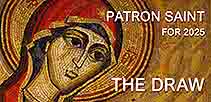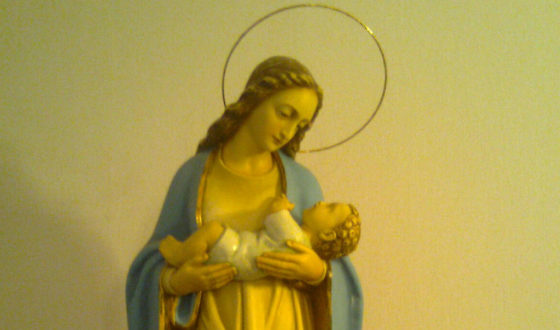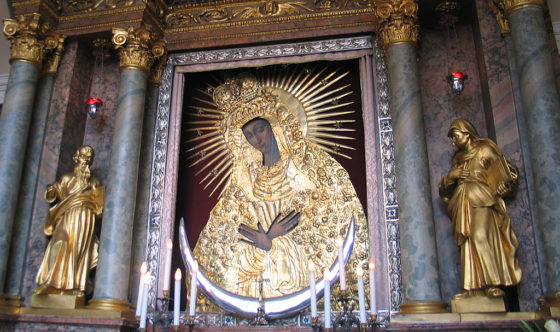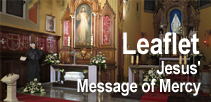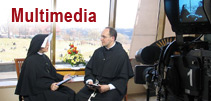Devotion to Our Lady dates back to the second century after Christ, and it developed widely during the Middle Ages. Mary was venerated as the Mother of God, Queen and Mother of countries, nations, cities, religious orders, religious and secular organizations, and also as the Mother of every human being. The devotion to the mercy of Mary first developed in the East, and was then adopted by the Church in the West, which gradually developed the devotion, deepened it and gave it its own form visible in the areas of devotion and iconography. In the late eighteenth and nineteenth century, the idea of Mater Misericordiae began to dawn. In our own time, however, we have seen not only an increase in devotion to the Divine Mercy, but also an increase in devotion to Our Lady of Mercy and a deepening of theological reflection associated with this title of Mary. These can be seen most clearly in John Paul II’s encyclical “Dives in Misericordiae” and are also evident in MA theses on this subject, written at university theology faculties.
The veneration of Mary in the mystery of mercy was first revealed in the faith of the people, and then in specific practices approved by the Church. The oldest prayer to the Mercy of Our Lady began with the words: Beneath thy mercy, we take refuge, O Virgin Theotokos … This prayer dates back probably to the early fourth century, as seems to be indicated by the use of the term Theotokos (Mother of God). This prayer first served for the private use of the faithful, and was then entered into the Church’s liturgical books. In the West it was known before the ninth century, in versions with no direct appeal to the mercy of Mary but with a reference to surrendering oneself to her care, as to a powerful Lady. We fly to your Patronage Oh Heavenly Mother of God – so to this day reads the first sentence of this prayer in the Western Church.
During that period (ninth century) the notion of the mercy of Our Lady appeared also in the liturgy: in Marian sermons and in votive Masses in honour of Mary, written for private use by Alcuin (+804) – the greatest theologian of that time. It is likely he is also the author of the famous prayer “Ad sanctam Mariam” which shows on the one hand the unique purity and dignity of Mary, emphasizing the greatness of Mary’s mercy, and on the other hand the unworthiness and abomination of sinful man. For some time this theme became a leading thought in all the prayers that refer to the mercy of the Mother of God.
The prayer “Salve Regina” was of particular importance for the development of the devotion to the Virgin of Mercy. This prayer was probably written in the tenth century and quickly spread throughout the whole Church. In it praying people turn to Mary as Queen and Mother of Mercy, for she is the Mother of the Son of God. In the original version the prayer began with the words: Salve, Regina misericordiae; the word Mater was added at a later time. In the next sentence, Mary is called: our life, our sweetness and our hope. Mary is called our life because she begot Christ, from whom everyone receives God’s life. She is called our sweetness because her maternal heart lives only by the love of Christ and shows this love to anyone without exception. Finally, Mary is called our hope because as the Queen and Mother of Mercy, she is our reliable advocate with God. It is a Christocentric prayer, for Mary owes her mercy role to Christ and shows her mercy through her maternal intercession. The words of the prayer emphasize that Christ is the ultimate goal of her mercy, because the prayer ends with the request: and after this our exile, show unto us the blessed fruit of thy womb, Jesus.
In the West the Benedictine Abbey of Cluny (founded in 910) worshiped Mary under the title Mother of Mercy in a special way. Its Abbot St. Odon (+942) was an avid proponent of the title. However, St. Fulbert is considered to be the first theologian of Mary’s mercy in the West. Although he did not write any theological treatise, he presented the mercy of Our Lady in his sermons and prayers. St. Fulbert preached that Christ is the source of all mercy. However, Mary can be called the Mother of Mercy, since by giving birth to Christ, at the same time she gave birth to the source of mercy for us. Her mercy is manifested in interceding with God for forgiveness of sins and all the graces. Her powerful intercession with her Son means that the righteous can more quickly obtain from him whatever they ask Him through His Mother; sinners also obtain mercy more often. St. Fulbert is the author of the term Mater Misericordiae et pietatis (Mother of Mercy and Compassion), which he used in his prayers to the Virgin Mary. The term was adopted in the Church and is still used today. The term Mater Misericordiae can mean not only the Mother of the Son of God, Who is the source of all mercy for us, but also the Mother of God who has a motherly heart for people, which is willing to show mercy. However, the term Mater pietatis primarily refers to acts of mercy shown to us by Mary as Mother.
A prayer to Mary’s mercy, written by Maurillus (+1057), a Benedictine who later became the Bishop of Rouen, became very popular in the eleventh century, especially in France and England. The prayer perfectly reflects the Marian spirituality of the period, which stressed the great disproportion between, on the one hand. Mary – holy and unblemished Mother, the only one pleasing to God – and, on the other hand, man who had a sense of unworthiness due to his weakness, misery, the abomination of sin, a feeling of being held in contempt by God. This unusual sense of one’s own misery, moral unworthiness, in contrast to the exceptional purity and holiness of Mary gave rise to great faith in her mercy, even though the one who asked did not speak to her as a son to his mother, but as a servant to the Mother of God, Lady and Queen. In the prayer, people cried out: To whom are we to sigh, poor and abandoned as we are, lamenting all the evil of our misery and poverty, if not to you the true and reliable Mother of Mercy? Holy Mother, Immaculate Mother, most pure Mother of Mercy, Mother of compassion and understanding, open your bosom of mercy and receive those who are dead in sin!
A slightly different approach to the mercy of Mary can be found in the prayers of Anselm of Lucca, contemporary to Maurillus, who intended the prayer to Our Lady for the saintly person, and not for the wretched sinner, because he wrote these prayers at the request of Princess Matilda of Tuscany, whom Pope Gregory VII commended to him for spiritual guidance. In these prayers Mary owes her function, Mother of mercy, to Christ, because He after His Ascension, handed down to her the whole legacy of mercy. For this purpose he also chose her as His mother, so that through her sinners could obtain forgiveness of sins from God. Mary’s mercy in the texts of these prayers is so powerful that it even appeared to be set in opposition to God’s justice: that is to the stern but righteous Son and to the anger of God the Father. This idea of opposing the mercy of Mary to the justice of God remained for many centuries (it can be found even today) and in its extreme form it denied mercy even to Christ, and granted it only to His mother. Elements of the spiritual motherhood of Mary can be found in the texts of Anselm of Lucca’s prayers, as she through the Eucharist shapes Christ in the souls of men. In the context of the Eucharist, her divine motherhood begins to become spiritual motherhood to people, yet Mary is still referred to as the Mother of God, as our Lady and Queen, and not as the Mother of men.
Devotion to the mercy of Mary in its theological and devotional dimensions reached its peak in the teaching of Saint Anselm of Canterbury, where he included it in three prayers written at the request of a brother monk. These prayers, intended for reading and meditation rather than recitation, were written from the viewpoint of a man striving for perfection, and who finds himself in different states of mind. The first prayer was intended for a man in a state of indolence of mind, the second – for a man who is seized with anxiety, and the third – to implore the love of Mary and Christ. The first prayer shows a man who because of his sins does not dare to appear before God, and therefore asks mediation of Mary, who has an unusual sanctity, and at the same time has great power and mercy. The text is to awaken in the praying person the feeling of admiration for the Mother of God, trust in her mercy, and faith in the effectiveness of her intercession, and then to lead the praying person to believe that there is no other salvation for him, other than by completely surrendering himself to her care. For her intercession can obtain forgiveness even for the greatest sins. The second prayer of St. Anselm is meant for the man who has broken with sin, but feels weak, does not trust himself and therefore seeks help from Mary. She is the mighty and merciful Lady, as Christ is the source of her mercy. Although both of them are merciful, they differ in their way of showing mercy. Christ shows mercy of His own accord, but Mary on the other hand through the intercession to her Son. Together they carry out the joint work of mercy to the people. St. Anselm never opposes the mercy of Mary to the righteousness of Christ. We can read in the text of the second prayer of St. Anselm: O God, who for mercy’s sake became the Son of Woman; O Woman, who for mercy’s sake became the Mother of God; through your forgiveness, through your intercession, have mercy on the poorest of the poor! Or else show me to whose greater mercy I might more safely draw near? Show me in whose greater power I might more confidently trust …
In the third prayer, St. Anselm presents Mary as the Mother of mercy, who, not only as the Mother of God and the Queen, but also as the Mother of people provides them with help and mercy. As a mother she loves her children and wishes that they should love her too. This was the first prayer to address Mary as our Mother, which led to a significant breakthrough in Marian devotion in the consciousness of the Medieval man. While still nurturing a great reverence for Mary as Mother of God, Queen and mighty Lady, at the same time people began to refer to her as their Mother. This idea resulted in the development of Mary’s spiritual motherhood.
St. Bernard of Clairvaux (+1153) contributed to the universal spread and final consolidation in the Church of devotion to the mercy of Mary. He enjoyed great authority and was marked by great zeal for the glory of the Mother of God, reverence for whom he preached not only among the clergy, but primarily to the faithful in general, which meant he had a huge impact on the development of devotion to Our Lady in the West. In the texts of prayers and sermons he used language which was accessible to all, so the truths preached by him were quickly adopted and popularized. St. Bernard of Clairvaux wrote in one of the prayers: “We praise your virginity and honour your humility; but it is your mercy that draws us closer to you, poor sinners that we are, and we embrace it with greater love. (…) Your most powerful and most merciful love is full of compassion for us and gains for us the help we need. Let my thirsty soul run to this source; let our poverty run to this excess of mercy with all haste … May your mercy reveal to the world the grace you found with God, May your holy prayers implore forgiveness for the guilty, healing for the sick, strength for the fainthearted and freedom for those who fall.”
St. Bernard pointed out for the first time that Mary shows mercy not only when people ask her for it, but always, since mediation in entreating favours belongs to the nature of her maternal mercy. St. Bernard wrote: ”Why would she not grant gifts, since she does not lack the power or the will? She is the Queen of Heaven and Queen fully merciful. Above all she is the Mother of the only Son of God.” While developing the doctrine of Mary’s mediation, St. Bernard wrote that Christ alone could suffice as an intermediary with God, but people worship the divine majesty in Him, see a Judge in Him and feel shyness, and therefore “Mary should properly be joined to Him, because she alone, blessed among women, is not found idle, and she has her place in this reconciliation. There is thus need of a mediator with this Mediator and none serves us better than Mary … What indeed could human weakness fear when approaching Mary? She poses no danger, no dread: she is sweet… full of grace and mercy… Be grateful to Him Who gave you such a Mediatrix, from whom there is nothing to fear.”
The teaching of St. Bernard consolidated for the next centuries the devotion to Our Lady of Mercy. In subsequent generations, although a new prayer, sermons and songs were written in praise of the mercy of Mary, they did not bring anything new to the doctrine of the mercy of Mary. The devotion to the mercy of Mary throughout the centuries was a private form of devotion in the West, because there was no liturgical devotion to Our Lady of Mercy in the Church. Also in the teaching of popes the title of Mother of Mercy appears only in the sixteenth century with Gregory XIII, then with his successors, but initially in the collection of titles with similar content. It was only Pope Leo XIII who undertook the topic of Mary’s mediation and her motherhood of Christ and her spiritual motherhood towards people, and who treated her charity as a basis for mediation with God and one of the manifestations of her spiritual motherhood towards people. Pope Leo XIII wrote that “Thus do those whose actions have disturbed their consciences need an intercessor mighty in favour with God, merciful enough not to reject the cause of the desperate, merciful enough to lift up again towards hope in the divine mercy the afflicted and the broken down.” (Octobri Mense 4).
Pope Pius XII emphasised that the mercy of Mary is a sign of her motherly love for people. This love is rooted in Christ Himself. The Pope not only calls Mary the Mother of mercy, but also gives her the title “Mother of God’s love”, not only because she gave birth to Christ (God’s love for us), but also because she has this love in herself and she has the ability to awaken it in human hearts. Pope Pius XII turned to Mary in the prayer: “Mother of Divine Love, for us who are thy sons keep guard over the fire of God’s love. Kindle it in ardent hearts. Revive it in lukewarm hearts. Light it in the indifferent hearts of those by whom it has been let die. Restore to the life of this Love those poor souls who have lost it through sin. To all those who beg you, O Virgin of Divine Love, grant your generous and consoling motherly blessing!”
Pope Pius XII, while juxtaposing the titles of God, who is the Father of mercy and of Mary, Mother of Mercy, indicates that the devotion of God the Father rich in mercy can be seen as the source of devotion to the mercy of Mary. It should be emphasized that other forms of worship of the Mother of God have developed from the devotion to the mercy of Mary, still they all have their source in her motherly mercy.
In Poland, the devotion to Our Lady of Mercy has been connected for nearly 400 years with the miraculous painting of Our Lady of the Gate of Dawn (Matka Boska Ostrobramska), which was solemnly crowned in 1927. Copies of the painting decorate not only the churches dedicated to Our Lady of Mercy of the Gate of Dawn, but also other churches, chapels, monasteries and the homes of believers. Pope Pius X granted permission for the votive Mass in honour of the Blessed Virgin Mary, Mother of Mercy. On November 16th in Lithuania and in the Archdiocese of Białystok in Poland the liturgical solemnity is celebrated in honour of Mother of Mercy of the Gate of Dawn, and the feast is celebrated in the Diocese of Łomża, Warmia and Drohiczyn. Before the ceremony at the Gate of Dawn, a special novena is held in some churches and communities.
The devotion to Our Lady of Mercy is still alive in the Church, and the dynamics of its development is undoubtedly affected by the developing devotion of Divine Mercy in the forms handed down by St. Faustina, who belonged to the Congregation of Our Lady of Mercy. The painting of Merciful Jesus, executed according to St. Faustina’s vision, was first exhibited for public veneration in the Shrine of Our Lady of Mercy of the Gate of Dawn. These are not coincidences, but the deep mysterious working of God, leading the understanding of the mystery of His mercy revealed in Christ and through Christ and in His Mother, and by her maternal mercy.
Prepared by Sr. Elizabeth M. Siepak ISMM, on the basis of Fr. Andrzej L. Krupa, Maryja Matką miłosierdzia, w: Ewangelia miłosierdzia (Mary, Mother of Mercy, in the Gospel of Mercy), Pallottinum, Poznan-Warszawa 1970, pp. 113-173.
Translated by Orest Pawlak










